How to Legally Install CCTVs in Singapore for Homes or Commercial Use

Closed-circuit television (CCTV) cameras are widely used for both residential and commercial purposes.
Installing CCTV cameras on company property is crucial for business owners because it assures the protection and safety of workers and workplace tools.
For people, installing a CCTV camera in their house may provide working parents piece of mind about the welfare and safety of their kids or elderly parents. Furthermore, those who want to gather proof of, or prevent, harassment, theft, or vandalism may find that putting CCTV cameras outside the house is vital.
This page gives a general summary of Singapore’s legislation governing CCTV camera installations at homes and businesses, as well as the actions you may take to make sure your installation conforms with the law.
Step by Step Guide on How to Install CCTV for your Premises
Step 1: Finding the Ideal Home for Your Cameras
When setting up CCTV cameras, strategic placement is key to capturing clear footage without being affected by harsh lighting. Avoid positioning them where direct sunlight or strong external lights might cause glare, hindering visibility. Opt for corners indoors, providing a wide view of entry points, akin to choosing a vantage point in a café to observe entrances and exits effortlessly. Outdoors, aim for elevated positions resembling watchtowers, overseeing doors and windows. Ensure practicality by placing cameras near power sources and at least 10 feet high, similar to mounting a birdhouse out of reach of curious cats.
Step 2: The Art of Cable Management
Picture your CCTV system as an intricate network of connections, where each cable serves as a vital link between the central hub (DVR) and the visual sensors (cameras). The objective isn’t merely to lay down these cables but to intricately thread them through your space, ensuring efficiency and discretion. The aim is to establish seamless connections from each camera to the DVR without cluttering your environment with a chaotic tangle of wires.
Here are some things to ponder:
- The male power plug, like the key to your system, stays with the camera. Think of it as ensuring that each camera has its own power source, much like making sure every appliance in your home has access to a socket.
- The pathway for these cables is crucial. Plan it like you’re charting a secret passage from one end of your house to the other. Using wire moldings is like laying down tracks for a miniature train; it keeps everything organized and out of sight.
- Securing the cables within these moldings with care ensures they are protected and unobtrusive, akin to tucking away your garden hoses after watering the plants to keep your garden neat and tidy.
Step 3: Breathing Life into Your Cameras
This stage is akin to giving your garden plants the right amount of water—neither too much to drown them nor too little to leave them thirsty. The DVR and cameras, much like plants, draw their vitality from a single source: the power supply. It’s a harmonious ecosystem where each camera connects to the power supply splitter, similar to how each plant’s roots extend to the soil for nourishment. This setup ensures that every camera, every eye in your security network, remains alert and ready.
When positioning and mounting your cameras, think of it as placing a picture frame or a shelf. You want it to be both visually appealing and functionally robust. Mark your spots carefully, drill with precision, and secure your cameras firmly—much like ensuring a precious family photo or a cherished keepsake is displayed safely and attractively. This careful placement not only optimizes the camera’s field of view but also integrates it into your home’s aesthetic.
Step 4: The Heartbeat of Your Security System – The DVR
Connecting your DVR to its power source is like plugging in the heart of your home’s security system. It’s the moment when everything comes together: the cameras are the eyes, the cables are the veins, and the DVR is the heart, pumping life into your entire CCTV setup. This step is straightforward but critical, much like turning on the main switch to illuminate your house after sunset.
Ensuring your DVR is safely housed is akin to protecting a treasure chest. It contains valuable recordings—moments captured, movements noticed, a comprehensive log of the comings and goings around your property. Securing the DVR in a locked compartment ensures that, even if an intruder were to discover it, the recorded evidence remains safe, much like safeguarding the diary that holds your deepest secrets.
The DVR’s location is not just about security but also about convenience and peace of mind. It’s like choosing the perfect spot for your jewelry box or important documents—accessible to you but hidden from prying eyes, ensuring that your home remains a sanctuary.
Step 5: The Connection
Connecting your monitor to the DVR is akin to setting up a new television for the first time. There’s a sense of anticipation and excitement as you prepare to bring a new world of visuals into your space. Whether you’re using a BNC, Scart, or VGA lead, think of it as choosing the right cable to connect your DVD player or streaming device to your TV. It’s about making sure the images captured by your cameras are displayed clearly and effectively on your monitor, transforming it into a window that offers a live view of your surroundings.
For those with a TFT monitor, referring to the manufacturer’s instructions is like consulting a recipe before baking a cake. You want to ensure you’re combining the ingredients correctly for the best result. By connecting your monitor properly, you ensure that the feed from your CCTV system is as clear and crisp as a beautiful autumn day.
Preparing the video cable for connection is somewhat like preparing a fine meal. You carefully strip the cable, revealing its inner workings, and connect it with precision, ensuring a secure and stable link between your DVR and monitor. It’s a delicate process, but when done correctly, it brings the entire system to life, offering you peace of mind and a reliable view of your property.
Step 6: Programming Your DVR – The Brain of the Operation
This final step is like setting up a new smartphone or computer. It’s about personalizing the settings, installing any necessary software, and getting familiar with its capabilities. Your DVR is the brain of your CCTV system, where all the information is processed, stored, and managed. Programming your DVR is crucial to ensure that it operates efficiently, capturing and storing footage as intended, much like customizing a new device to suit your needs and preferences.
Depending on your system, you might need to install a hard drive or simply power on and follow the on-screen setup instructions. This process is like opening a new book for the first time—there’s a sequence to it, a right way to begin that sets the tone for everything that follows. Ensuring that each camera is working correctly and providing the desired view is akin to flipping through the pages of a novel, making sure none are missing or upside down.
Installing a CCTV system goes beyond technical setup; it’s about fostering security and tranquility. By carefully choosing camera locations and fine-tuning the DVR, you create a vigilant yet unobtrusive guardian, seamlessly integrated into your daily life.
Choose Us as Your Preferred CCTV Installer
Choose First Solution Group, Singapore’s best CCTV security systems company, where unparalleled expertise meets innovative technology. Our 10+ years in the field, coupled with a remarkable installation tally of over 500,000 CCTVs, underscore our commitment to your safety and satisfaction. We stand ready 24/7 to support your security needs with tailored, state-of-the-art solutions that promise comprehensive surveillance and peace of mind. When security is your priority, make First Solution Group your first choice for dependable, cutting-edge CCTV installations that protect what’s invaluable to you.
Legal Implications for Setting Up CCTV Cameras at Homes
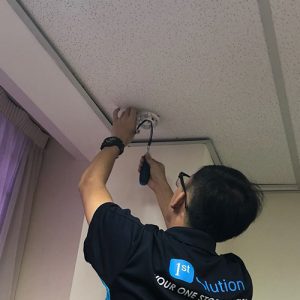
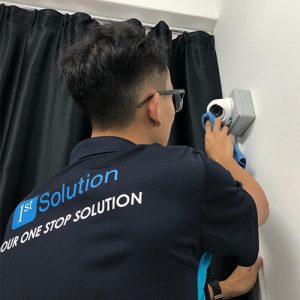
Is it possible to put CCTV cameras inside my house?
There is no need to acquire authorization from the government if you want to install CCTV cameras inside your house.
This does not, however, imply that there are no limitations on how a CCTV camera may be mounted.
You should be aware that HDB does not allow the installation of CCTV cameras inside of apartments for the purpose of carrying out common area monitoring.
Your neighbor may file a complaint with the HDB if he is aware that you have installed a CCTV camera in your apartment and considers that the monitoring is unreasonably invasive (for example, if the camera is positioned such that it focuses on and records your neighbor’s unit). The HDB could send someone to look into the complaint and request the CCTV camera’s removal.
If you utilize the CCTV camera to monitor your neighbor’s movements, whether you reside in private or public property, you run the risk of being sued by him for interfering with his right to enjoyment of his property. Below, we go into greater depth about this.
Can I set up CCTV outside my house?
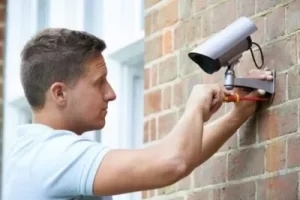
The sort of property you reside in will determine whether you are allowed to install CCTV cameras outside your house.
Installing CCTV outside a HDB apartment
Town Council bylaws govern the installation of CCTV cameras outside of your HDB apartment. This is so because the space outside your apartment is regarded as common property and is overseen by the Town Council.
According to the bylaws, you need permission to put any building, fixture, or item in common spaces, including CCTV cameras. Without previous authorization, installing CCTV cameras may result in a fine of up to $5,000.
How to get the Town Council to approve the installation of CCTV cameras
To report the wrongdoing of your neighbors or other people, you must do so first (that call for a CCTV camera to be installed). This is a crucial step since the Town Council won’t authorize a request for an installation unless they have a police report.
Send an email with a copy of the police report asking for permission to install a CCTV camera in your HDB estate. You will get an email informing you of the conclusion after the approval procedure, which should take 1-2 weeks.
Once it has been given the go-ahead, you may buy and install the CCTV camera. Installation of CCTV cameras is allowed for a maximum of 6 months on a temporary basis. You will have to make a new request when this one runs out.
Putting up a CCTV camera outside a condo unit
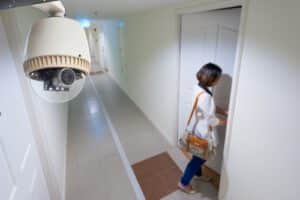
The MCST regulations or bylaws governing your estate may include restrictions on the installation of CCTV cameras outside of condominium units. To make sure you adhere to any restrictions, including whether you need to apply for clearance and the maximum time a CCTV camera may be placed, you should review these bylaws.
Placing a CCTV camera on a piece of real estate
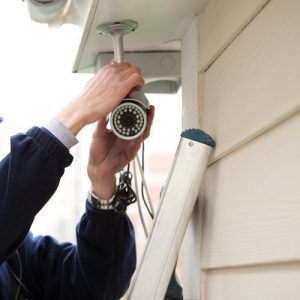
On any area of your landed property complex, you may install CCTV cameras.
Are built-in cameras on doorbells and peepholes that capture audio and/or video considered CCTV cameras?
Video and/or audio recording features on doorbells and peepholes are becoming more and more widespread. Depending on the kind of property you reside in and whether the devices are located inside or outside the property, authorization may be required to install such equipment, which are classified as CCTV cameras.
For instance, the Town Council’s permission is required if you want to put such a doorbell outside your HDB apartment (see above for the procedure). This is due to the fact that the space outside your front door is regarded as community property.
Peepholes don’t need the Town Council’s permission since they are linked to your door and are seen as being within your HDB flat. However, as was previously said, you should be considerate of your neighbors’ worries. Your neighbors have the right to complain to HDB if they believe that it is too invasive and amounts to monitoring of the shared spaces.
Can I set up my own CCTV cameras?
You are not allowed to install CCTV cameras on your own, even if you have the necessary authorization.
According to the Private Security Industry Act, a Security Service Provider license is required for anybody installing CCTV cameras. This implies that you need still engage a person with a Security Service Provider license to install the camera for you, even if you decide to acquire the CCTV camera yourself from a website.
You should make sure the individual installing the camera is qualified to do so if the purchase of your CCTV camera includes installation services.
What regulations must I follow while using my CCTV cameras?
No encroachment on a neighbor’s right to enjoy their land
The Personal Data Protection Act (PDPA) of Singapore only applies to organizations; it does not specify what may be seen on CCTV video that is acquired for individual (i.e., non-business) use.
However, you are required under the Community Disputes Resolution Act (CDRA) to abstain from interfering with your neighbor’s pleasure or use of their home. Regardless matter whether the CCTV camera is placed outdoors in public locations or within your house, this requirement still stands.
A “neighbour” for CDRA purposes is someone who resides in the same building as you or within 100 meters of your home.
For instance, if your CCTV camera is pointed at your neighbor’s apartment or the landing of the stairs outside of his main entrance and is recording his actions, you are probably interfering with his enjoyment of his property. The CCTV camera should be positioned such that it concentrates on recording images right outside the main entrance of your apartment in order to avoid fines under the CDRA.
Your neighbor may file a complaint with the Community Disputes Resolution Tribunal, which has the authority to issue a range of court orders, if you interfere with his ability to enjoy his land. For instance, you can be compelled to pay your neighbor up to $20,000 in damages and/or asked to adjust how the CCTV camera is mounted or remove it altogether.
- The removal of the CCTV camera after the authorized installation period has passed.
- The Town Council will only permit the installation of CCTV cameras outside your HDB apartment for the predetermined time period mentioned above.
- You must take down the CCTV cameras as soon as the authorized installation period is up to avoid breaking Town Council bylaws. A $5,000 fine may be assessed for noncompliance.
- Similar MCST regulations or bylaws on installation length durations may also be applicable to condominium residents.
Setting Up CCTV Cameras for Commercial Use
Installing CCTV cameras for a company is more difficult than installing them for a house since businesses, as opposed to individuals, are subject to the Personal Data Protection Act (PDPA).
The PDPA requires that CCTV camera footage be collected, used, and disclosed in situations where the camera will record personal data, such as video that can be used to identify specific people.
Summary of the PDPA
The PDPA requires organizations to comply with the following three requirements, among others:
Unless the person has given consent—or is deemed to have given consent—to the collection, use, or disclosure of their personal information, the organization is not permitted to collect, use, or disclose that information.
Collection, use, and disclosure of personal data must be done for reasons that a reasonable person would deem appropriate under the circumstances.
Obligation to notify: The organization is required to let the person know why their data is being collected, used, or disclosed.
These responsibilities will be discussed in the context of CCTV camera video in the sections that follow.
Can I put up CCTV outside or inside my office building? What guidelines do I have to follow while using the CCTV cameras?
CCTV cameras may be placed inside or outside your commercial space. The PDPA does not forbid businesses from setting up CCTV cameras that record images outside of their physical location.
Nevertheless, depending on whether the location where the CCTV cameras are to be installed is open to the public, you might be required to comply with PDPA requirements. This is so that businesses are not required to follow certain requirements when it comes to publicly accessible personal data, i.e. when the personal data is seen at a public location with little to no access restrictions.
In general, places like malls, shops, or restaurants would be regarded as publicly accessible business locations, whereas places like offices that require a keycard to enter would not.
According to whether your company’s location is open to the public, the following table lists the PDPA requirements that must be followed:
| Consent obligation | Reasonable purposes requirement | Notification obligation | |
| Public access locations | Although it is good practice to do so, you are not required to get clients’ permission. | You must make sure that the CCTV footage only uses personal information for legitimate purposes. | Although it is not required, it is a good idea to let customers know that CCTV cameras are watching them. |
| Non-public access locations | Customers’ permission is required, and you should get it by posting notices. | You must make sure that the personal information gathered from the CCTV footage is used only for legitimate purposes. | Customers must be informed, and you should do so by posting notices. |
Factors to Take into Account When Fulfilling the Consent and Notification Duties
It should be noted that regardless of whether your premises are open to the public, you must adhere to the consent and notice requirements as stated above if you plan to install the cameras outside the business premises in a location that is not accessible to the general public.
Rules for Posting Notifications
You can post signs at the building’s entrances warning visitors that CCTV cameras are being used to gather their personal information.
This will fulfill both the PDPA’s notification and consent requirements because anyone who views the sign is presumed to have given his consent upon admission.
As a general rule, the notification should not only include a picture of a CCTV camera but should also specify its function, if it is not immediately clear (for example, “placed for security purposes”).
Factors to take into account when adhering to the reasonable reasons requirement
This requirement must be followed when installing CCTV cameras in both publicly accessible and privately accessible commercial spaces. The organization must determine whether the available coverage’s extent is appropriate for adding CCTV cameras in order to meet this responsibility.
The PDPA does not forbid the installation of CCTV cameras outside of commercial premises, as was already mentioned. To make sure that any such installation complies with the reasonable objectives criterion, you should take extra precautions. This is due to the fact that it could be more challenging to defend comprehensive CCTV camera surveillance outside the business premises.
For instance, it can be deemed permissible for CCTV cameras to record footage outside of the factory if its primary function is to ensure the security of the facility (e.g. the footage would provide information on how trespassers entered the premises).
On the other hand, the organization may be in violation of PDPA responsibilities if the scope of coverage is not judged to be fair.
Locations where CCTV cameras shouldn’t be installed
CCTV cameras shouldn’t often be put in restrooms or locker rooms. Installation at certain locations could be considered voyeurism or an insult to modesty, which are both criminal offenses.
Additional PDPA requirements that you must follow.
Access is required. Individuals have the right to request access to their personal data, which includes CCTV footage of them, under sections 21 and 22 of the PDPA.
Within a year after receiving the request, the organization is required to give the person the video that it has that includes them, along with details on how it has been used or disseminated, as soon as is reasonably reasonable.
This responsibility is applicable to any CCTV camera material, whether it was shot in a business location that was open to the public or not.
What if the CCTV footage includes another person’s personal information?
When granting access will also reveal the personal information of another person, an organization is not allowed to do so under section 21(3)(c) of the PDPA. This situation occurs frequently because CCTV often photographs multiple people moving at once.
The PDPC has advised the organization in these situations to continue granting access if:
The organization is able to apply masking techniques, such as blurring other people’s faces in the CCTV footage, to hide their personal information.
The people who appear in the CCTV footage give their consent to the publication of their personal data, or the personal data captured in the CCTV footage is publicly available, such as when the CCTV footage records movements in commercial locations that are open to the public.
For the expenses incurred in responding to the access request, the organization is permitted to charge a reasonable price.
Retention of surveillance video
Organizations must take care to avoid keeping CCTV footage after it has served its intended function or when there are no longer any legitimate commercial or legal reasons to keep it.
The PDPA does not specify a set retention period for CCTV footage, and what is deemed an adequate period would depend on your organization’s operational requirements. When it is no longer necessary for your security needs, for instance, if you are collecting CCTV footage for security reasons, you should erase the CCTV footage.
The PDPC advises organizations to periodically evaluate the CCTV footage they have gathered to make sure it is not kept for an unreasonable amount of time. Each organization should create a personal data retention policy that outlines the duration for which it plans to keep records containing personal data, such as CCTV video, as well as its justification.
What if someone asks me to remove the CCTV footage of him?
An individual has the right, with reasonable notice, to revoke his permission to the collection, use, or publication of his personal data, including CCTV video.
If a person withdraws his consent, your organization should stop using the CCTV footage it has gathered or sharing it with anyone in the future.
However, organizations are not required to remove or destroy a person’s personal information at his request. As a result, your organization is not forced to delete the CCTV footage and is free to keep it as long as it is still needed for administrative or legal reasons.
Penalties for violating PDPA requirements
For a first offense, the standard punishment for violating PDPA requirements is a fine of up to $10,000 or a period of imprisonment of up to three years, or both.
The Management Corporation Strata Title Plan No. 3593 (MCST) & Others case serves as a helpful example of the possible repercussions of violating PDPA requirements. In that instance, it was determined that a security firm hired by the MCST of a condominium had violated PDPA requirements by releasing CCTV footage without permission.
The CCTV footage of the condo lobby, which included the personal information of other people, had been requested by a condo resident. Without getting permission from the MCST, a security guard working for the security firm sent a copy of the CCTV footage to the resident via WhatsApp.
The court determined that because the MCST had chosen the security firm, it was their responsibility to ensure PDPA compliance. The MCST was ordered to pay a $5,000 fine for violating the PDPA; this lower amount was based on the fact that the MCST voluntarily informed the PDPC of the violation and took prompt corrective action.
The security firm was also required to implement a data protection policy and train its staff on how to handle personal data.
Are the CCTV cameras self-installable?
A license is required by the Private Security Industry Act for anyone installing CCTV cameras in order to offer security-related services. As a result, you are not allowed to install the CCTV camera yourself and should instead use the installation services of a person who has a Security Service Provider license to do so, as was mentioned above.
—
The installation of CCTV cameras for residential or commercial use in Singapore is subject to a number of laws that must be followed, despite the fact that they can be very useful.
It is advised that you speak with a data protection attorney if you are a business owner and are thinking about installing a CCTV camera for your workplace. A lawyer can assist you in navigating and adhering to the PDPA’s complex personal data protection requirements so you can stay out of trouble and avoid paying a fine.